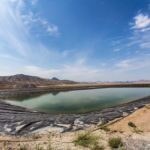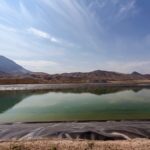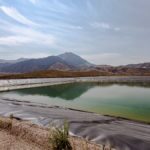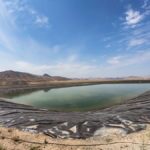History
The Cortez mine is situated in Crescent Valley between the Cortez and Shoshone Mountains. The area has been mined since 1862 with silver being the primary commodity until the 1940’s. In 1969, the U.S. Bureau of Mines built a pilot plant that made heap leaching of gold viable. Beginning around 1971, low-grade ore from the Gold Acres deposit at Cortez was heap leached, shifting the mine to a gold operation. The mine went through a variety of owners including Placer Dome in partnership with Kennecott. Barrick Gold became the sole owner after purchasing 60% of the mine from Placer Dome in 2006 and the remaining 40% from Rio Tinto in 2008. Multiple feed deposits have kept the mine going, including the Horse Canyon, Pipeline, Foothills, and most recently, Gold Rush deposits.
Problem
The Cortez mine and surrounding region is in northern Nevada where surface water is scarce, creating a need for sustainable water solutions during mining operations. A pond for water storage was built in the late 1980’s out of a flexible material called VLDPE. The material had excellent elongation and weldability properties but offered limited resistance to solar and UV, causing it to break down rapidly when exposed to sunlight. The VLDPE liner was removed and replaced with high density polyethylene (HDPE), but this material also proved to be prone to breakdown, causing leakage through the double liner. The harsh weathering, steep slopes, and overall mining operations overwhelmed the containment system. A design with a significant drainage solution was needed.
Solution
To remedy issues with the pond, the company brought in Newfield Engineers in 2017. The group designed a new 625,000 square foot, double-lined pond using AGRU America 60 mil single-sided HDPE MicroSpike liner, with a 200 mil AGRU Geonet as the separator between liners to guarantee quick flow to the leak detection sump. Faster, more exact leak detection enables crews to pinpoint and seal leaks.
In addition to the drainage solution, the engineers chose AGRU MicroSpike, a highly durable geomembrane liner with consistent friction angle values for slope stability. Engineers used thermal fusion welding to create an impermeable seal between adjacent sheets. All products were tested at AGRU America’s GAI/LAP certified lab for quality.
Outcome
Installation was performed by Sierra Geosynthetic Systems and to date has resulted in a leak-free pond.
Need Help Determining Which Product is Right For Your Application?
Interested in learning more about how one of our products can make a difference in your next project? Please reach out to us with your questions and one of our sales or technical staff will be happy to assist you.
We can help you determine your exact product or application-related needs. And because our products meet, and often exceed, industry standards you can rest assured knowing that you are getting the best solutions in the business.








